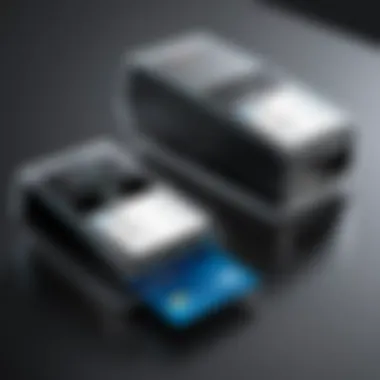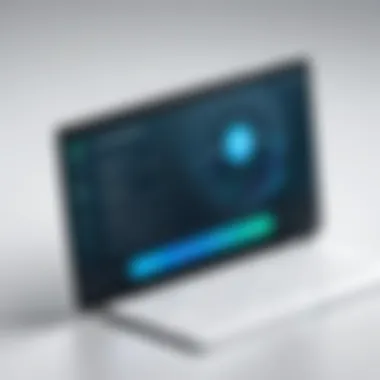Top Business Card Scanner Apps Reviewed


Intro
In a world where networking plays a crucial role in professional success, the ability to efficiently manage contacts is paramount. Business card scanner apps offer a solution to the ever-growing need for effective contact management. These applications transform physical business cards into digital contact entries, simplifying communication and network organization. However, choosing the right app requires careful consideration of various factors such as features, user experience, pricing, and the overall functionality of the software.
This article aims to provide a thorough analysis of the leading business card scanner applications on the market. We will explore the strengths and weaknesses of each app, their compatibility with different systems, and their pricing structures. By understanding these aspects, professionals in IT-related fields, software developers, and students can make informed decisions about which application will best serve their networking needs.
As we delve deeper, the article will offer insights into best practices for optimizing the use of these applications, ensuring that users can harness their full potential. By synthesizing the gathered information, we aim to deliver a comprehensive guide capable of enhancing networking efficiency.
Understanding Business Card Scanners
In today's competitive landscape, networking is crucial for business success. A business card scanner app streamlines this process, converting physical business cards into digital contacts. Understanding these tools is vital because they help simplify the transition from traditional networking methods to a more efficient digital system. Professionals from various fields, including IT, benefit from quick access to contact information without the clutter of paper cards.
Definition and Importance
A business card scanner app is software designed to extract information from business cards using Optical Character Recognition (OCR) technology. The app scans the card, interprets the data, and saves it in a digital format, often within the user's contacts list. This capability is important as it reduces manual entry errors and saves time. As networking opportunities arise unexpectedly, having a reliable tool can enhance the ability to connect with other professionals.
Furthermore, the importance of such applications extends beyond simple data entry. They facilitate organization, making it easier for users to categorize and retrieve contacts when needed. For instance, a software developer can quickly scan a card received at a tech conference, add notes, and organize contacts by events or project relevance. This functionality is indispensable in maintaining an effective network.
How They Work
Business card scanner apps utilize OCR technology to digitize information. Here's how they typically work:
- Capture: When a user takes a photo of a business card, the app processes the image in real-time.
- Recognition: The OCR engine analyzes the photo. It identifies text and distinguishes elements such as names, titles, phone numbers, and company details.
- Conversion: After recognizing the text, the app converts this data into a structured format compatible with contact management systems.
- Storage: Finally, the captured data is saved into the app's database or the user's contact list, often allowing tagging and note addition for further context.
This sequence not only highlights the efficiency of business card scanner apps but also their role in modernizing the networking process. They automate what once was a tedious manual entry task, allowing professionals to focus on building relationships rather than managing contact overload.
Key Features to Consider
When evaluating business card scanner apps, identifying key features can significantly influence the efficiency of your networking efforts. Understanding these features allows users to make informed decisions tailored to their specific needs. This section will delve into three essential features: Optical Character Recognition (OCR), Data Export Options, and Integration with Other Applications. Each of these components plays a crucial role in the overall effectiveness and usability of a business card scanner.
Optical Character Recognition (OCR)
Optical Character Recognition (OCR) technology serves as the backbone of any business card scanner app. OCR enables apps to convert various formats of printed text into machine-encoded text. This process typically occurs through scanning the card, which is then processed by the software to interpret the text.
The accuracy of OCR can vary among different applications. More advanced OCR capabilities ensure that contact information is captured without significant errors. This is particularly crucial since inaccuracies can lead to missed opportunities or miscommunication. In terms of user experience, an app with superior OCR will minimize the need for manual entry corrections, enhancing overall productivity.
Data Export Options
After capturing contact information, having flexible data export options is essential for seamless integration into existing systems. Many users require their scanned contacts to be exported to various formats, such as CSV or vCard, or integrated into their preferred contact management systems like Google Contacts or Microsoft Outlook.
Flexible export options facilitate better organization and management of contacts, simplifying the transition from paper to digital. A well-designed app should offer multiple export pathways, enabling users to adapt to their specific operational workflows. This could be invaluable for professionals who constantly balance numerous relationships and contacts across different networks.
Integration with Other Applications
The ability to integrate with other applications plays a pivotal role in maximizing the impact of business card scanners. Integration capabilities can range from linking with CRM systems to synchronizing with cloud storage solutions. This feature allows users to keep their contact list updated across multiple platforms without redundant data entry.
For developers and IT professionals, seamless integration enhances the functionality of the tools at their disposal. Such integrations empower teams to access and utilize contact information more effectively, potentially leading to improved collaboration and enhanced business outcomes. Choosing a business card scanner that offers robust integration options ensures that users can embed the tool into their digital ecosystems with ease.
"Choosing the right business card scanning app is crucial for effective networking; hence, understanding the key features is essential."
Top Business Card Scanner Apps
In today's fast-paced business environment, having a reliable business card scanner app is essential for professionals who want to manage their networking efforts efficiently. Business card scanners streamline the process of collecting and organizing contact information, ensuring that valuable connections are not lost. Choosing the right scanner app can greatly impact your productivity, as these tools often come with various features that enhance the scanning and data management experience.
When selecting a business card scanner app, key factors come into play, such as OCR accuracy, integration capabilities, and user friendliness. Understanding the strengths and weaknesses of different apps can guide users in making an informed decision tailored to their specific needs. A good scanner app optimizes the workflow by not just capturing contact details, but also by enabling easy access to data across multiple platforms.


CamCard
Features and Benefits
CamCard stands out in the market due to its intuitive design and useful features. One of its key characteristics is the robust Optical Character Recognition technology, which ensures high accuracy in data capture. This feature allows users to scan cards in multiple languages, making it a versatile choice for global networking. Another benefit is the ability to sync contacts across various devices, which adds convenience and accessibility.
A unique aspect of CamCard is its ability to create a digital business card from a user’s profile, allowing for seamless sharing. This is particularly advantageous for users who frequently attend networking events.
User Experience
The user experience of CamCard is tailored towards simplicity. Its interface is clean and easy to navigate, which attracts professionals who may not be technically inclined. Users report a quick learning curve, making it a popular choice among different demographics.
An important feature is the ability to add notes and tags to contacts, enhancing organization. However, some criticisms revolve around occasional misreads during scans, which can be a drawback in high-pressure situations.
Cost Analysis
In terms of cost, CamCard offers a free version with limited features. The paid options provide additional functionalities, such as unlimited scans. The pricing structure is competitive in comparison to other apps, making it a reasonable investment for businesses looking to enhance their networking efforts.
However, the ongoing subscription may deter some users who prefer a one-time purchase model.
ABBYY Business Card Reader
Unique Features
ABBYY Business Card Reader is known for its impressive OCR capabilities. The app can capture texts with a high level of accuracy, which contributes significantly to its effectiveness as a business card scanner. Another beneficial characteristic is its support for cloud storage options, allowing users to back up contacts to various services like Dropbox.
A distinctive feature is its ability to recognize and correctly parse complex layouts. This makes it especially useful when dealing with cards that have multiple elements.
Performance Review
Performance is a strong point for ABBYY Business Card Reader. Users frequently commend its speed and reliability when scanning. The app performs well in different lighting conditions, which adds to its usability in real-world scenarios. However, some users note that the app can sometimes struggle with older or less common card layouts.
Pricing Structure
ABBYY Business Card Reader operates on a freemium model. The basic app is free, but advanced features require a purchase. This pricing model is beneficial for those wishing to test the app before committing financially, but the full version's cost may seem higher in comparison to similar apps. Users appreciate the value of what they get; the accuracy justifies the price for many.
ScanBizCards
Highlights and Shortcomings
ScanBizCards offers an array of features that cater to various professional needs. Its highlight is the dual functionality of scanning physical cards and importing contacts from LinkedIn. This flexibility appeals to users who want a comprehensive tool for contact management.
However, some users report that the app can feel cluttered and overwhelming due to the number of features it offers, which may not be as user-friendly compared to competitors.
User Review Insights
User reviews often emphasize the app's effectiveness in quickly capturing contact details and managing them efficiently. Many praise the option to add additional notes during the scanning process, which helps in remembering more about each contact. On the other hand, there are mentions of occasional issues with the accuracy of scans, particularly with cards that have intricate designs.
Pricing Options
ScanBizCards has a free version with limited functionality, while its premium option offers unlimited scanning and higher accuracy. The cost is reasonable in relation to the features offered, making it appealing to those who require both basic and advanced capabilities.
Haystack
Key Features Overview
Haystack provides a no-nonsense approach to business card scanning with a focus on simplicity and effectiveness. One of the key features is its cloud-based system, which enables seamless updates of contacts across devices. Users can also customize their digital business cards, which can be shared via QR codes.


This personalized approach allows for uniqueness in sharing contact details, presenting a modern touch in networking.
User Experience Feedback
Users appreciate Haystack for its straightforward interface. New users tend to find it easy to understand, which emphasizes the app’s importance in a fast-paced environment. However, some feedback indicates limitations in support for non-English languages, which can be a problem in international contexts. Overall, users value efficient scanning and easy editing options.
Cost and Value
Haystack operates on a subscription basis, with different tiers that cater to various user needs. The cost is viewed as competitive considering the unique features it offers. Some users feel that the free version suffices for casual networking, while frequent users likely benefit from the enhanced features in the paid subscription.
BizCard
Distinctive Features
BizCard sets itself apart with advanced customization options that allow users to tailor their experience significantly. A notable feature is the ability to create a personalized QR code for cards, facilitating easy sharing without the need for physical exchange.
Additionally, it features an organized interface for categorizing contacts, making it easy to retrieve relevant information.
User Usability
User feedback emphasizes the app’s simplicity in finding and managing contacts. Its search functionality is strong, allowing users to quickly locate specific contacts based on notes or tags they have created. While generally positive, some users voice that the initial setup can be a bit tedious, requiring more time than expected.
Pricing Considerations
BizCard is moderately priced with varied options. The free plan allows users to test the app before deciding on upgrades. The cost for premium features is comparable to similar applications, ensuring good value for users who need more advanced capabilities. Users note that the features offered justify the investment for regular professionals.
Comparison of Leading Apps
In the realm of business card scanner applications, a thorough comparison is essential for users to make informed decisions. Different apps offer varying features, functionalities, and pricing structures, impacting the overall user experience. This comparison section helps distill these elements into clear insights, assisting professionals in identifying which app aligns best with their specific needs. By understanding the strengths and weaknesses of each application, users can maximize their productivity and enhance networking endeavors without unnecessary complications.
Feature-by-Feature Analysis
A feature-by-feature analysis allows users to understand the unique offerings of each business card scanner app. This aspect is important because it highlights what each app excels in and where they might fall short. Here are some key features typically assessed:
- Optical Character Recognition (OCR): This is the cornerstone of any good business card scanner app. High-quality OCR technology ensures accurate data capture from business cards.
- User Interface (UI): A well-designed interface improves user engagement and reduces the learning curve.
- Customization Options: Some apps offer customizable fields to cater to various contact details.
- Multi-Language Support: This is useful for users working in international environments, as it allows for scanning cards in different languages.
Each app has its distinct strengths, and understanding these can lead to more effective networking strategies.
Pricing and Subscription Models
Pricing is a crucial factor that can influence the choice of a business card scanner app. Users must consider both initial costs and long-term expenses. Here are common pricing models:
- One-Time Purchase: Some apps require a single payment for lifetime access. This can be cost-effective for long-term users.
- Subscription-Based: Other apps operate on a subscription model that may offer continuous updates and support. Users should weigh the ongoing costs against potential benefits and features.
- Free Versions: Many apps have free versions with limited functionality. They can be a low-risk way to evaluate an app before making a commitment.
Users should approach pricing models with an analytical mindset, evaluating their budget against the features they require.
User Satisfaction Ratings
User satisfaction ratings provide insights into real-world experiences with each app. These ratings are often available on various platforms and can reveal valuable information about reliability and customer service. Key aspects to consider include:
- User Reviews: Reviews often highlight strengths and weaknesses from a user perspective, providing deeper context than technical specifications.
- Support and Updates: Apps that provide consistent updates and robust customer support tend to score higher in user satisfaction.
- Overall Ratings: Aggregated scores from platforms can serve as a quick reference for determining an app’s general reception.
Engaging with user feedback is essential as it helps inform potential users about what to expect, enhancing the decision-making process.
"User satisfaction ratings can be more influential than specifications when selecting the right app for your needs."


Maximizing Efficiency with Business Card Scanners
Maximizing efficiency with business card scanners is crucial for professionals aiming to streamline their networking processes. In today's fast-paced work environment, the volume of contacts one encounters can be overwhelming. Therefore, utilizing business card scanning technology is not just about convenience; it is about optimizing one's workflow and ensuring accurate data management.
Best Practices for Scanning
To fully benefit from business card scanners, adopting specific best practices can significantly enhance the efficiency of the scanning process.
- Ensure Good Lighting: Always scan cards in well-lit environments. This helps the scanner capture clearer images, which can improve optical character recognition accuracy.
- Flat Surface: Place business cards on a flat surface. Curved or uneven surfaces can distort the image, leading to scanning errors.
- Regular Updates: Keep the scanning software up-to-date. Updates often include improved algorithms for OCR, which means better recognition of texts.
- Quality Check: After scanning, perform a quick check on the data captured. Any discrepancies should be corrected immediately to maintain a reliable database.
Organizing Contacts Post-Scan
The work does not end once the cards are scanned. Proper organization of scanned contacts is vital for efficiency.
- Categorize Contacts: Use tags or categories to organize contacts according to relevance, such as by industry or relationship strength. This simplifying further searches in the future.
- Create Custom Fields: Sometimes, the information on business cards does not fit into standard categories. Including custom fields for unique data helps maintain essential details.
- Integrate with CRM Tools: Many business card scanner apps offer integration with customer relationship management (CRM) tools. This feature is beneficial in ensuring a seamless workflow, as it allows for automatic data transfer and organization.
Maintaining Updated Contact Information
Keeping contact information current is as critical as the initial capturing of data.
- Periodic Review: Schedule regular checks of your contacts. This ensures that outdated information is updated and irrelevant contacts are removed. Over time, people change jobs or roles, making it essential to keep track of such changes.
- Encourage Follow-ups: After connecting with contacts, follow up via emails or messages. This not only confirms the details but also strengthens professional relationships.
- Use Data Sync Features: If the app supports syncing across devices, enable it. This ensures that the latest information is accessible from any device, minimizing the risk of working from outdated lists.
"Organizing contacts post-scan is just as important as the scanning itself; both processes directly affect your efficiency in networking."
By cultivating these habits, professionals can transform their networking endeavors, enabling more effective use of business card scanners. This ultimately leads to better relationship management and a more efficient workflow.
Future Trends in Business Card Scanning Technology
As business card scanning technology evolves, it is becoming increasingly vital for professionals to stay informed about the latest trends. This section will provide insights into emerging technologies and predictions for the market, underlining their significance for users who rely on these applications for networking. Understanding these trends can guide businesses in leveraging technological advances to improve efficiency, enhance user experience, and remain competitive.
Emerging Technologies
Emerging technologies are reshaping the way business card scanners operate. Notable advancements include improved Optical Character Recognition (OCR) algorithms, which allow for more accurate text recognition. These enhanced OCR systems reduce errors common in earlier versions, making digital contact information more reliable. Key developments in artificial intelligence (AI) and machine learning (ML) are contributing to this shift. AI can learn from past scanning practices and adapt, resulting in faster processing times and better overall performance.
Additionally, cloud-based solutions are gaining ground. These allow users to store, access, and share contacts across devices seamlessly. With cloud integration, users can view their contacts from anywhere, further boosting the efficiency of business communication. Other technologies include augmented reality, where users can scan business cards using their smartphones and view relevant information in real time, integrating additional layers of context.
Predictions for the Market
Looking ahead, the market for business card scanning apps seems poised for continued growth. Increased smartphone usage and the need for effective networking solutions will likely drive demand. The rise of remote work and virtual networking will solidify the role of these applications. Businesses will increasingly adopt tools that facilitate not only contact management but also engagement and relationship-building.
Experts suggest that subscription models will become more prevalent. Users may prefer monthly or annual subscriptions over one-time purchases, as this model provides ongoing updates and improved features without the need for constant manual upgrades.
Furthermore, as the competition among app developers intensifies, we might see innovative pricing strategies designed to attract new users. Some developers could explore freemium models, offering basic features for free while charging for advanced capabilities.
Culmination
In the realm of networking, business card scanner apps present a practical solution for managing a wealth of contacts. The importance of utilizing these applications lies not only in their efficiency but also in their ability to streamline the process of contact management. Traditional methods often involve manual entry, which can lead to inaccuracies and data loss. Conversely, business card scanner apps leverage technology to reduce human error, allowing users to capture information quickly and accurately.
The key elements within this article highlight various insights and considerations about the best business card scanner apps. These include their functionality, user experience, and how well they integrate with other tools essential for modern business practices. The emerging trends also signal an evolution in the technology that underpins these applications, likely leading to more advanced features in the future.
Summary of Insights
Throughout the analysis, several insights stand out:
- Diverse Features: Each app offers unique features tailored to different user needs, which means users can select one that fits their specific workflows.
- User Experience: Understanding the usability of each app can significantly influence user satisfaction and productivity.
- Pricing Models: The variety in pricing structures allows for flexibility that caters to different budgets, from freelancers to larger organizations.
- Integration Capabilities: Seamless integration with CRM systems and other applications enhances the overall utility of business card scanner apps.
In summary, users should prioritize what specific aspects are most relevant to their networking needs when exploring app options.
Recommendations
Given the landscape outlined, here are some recommendations for users:
- Evaluate Features: Take the time to assess which features are crucial for your needs. Do you require advanced OCR capabilities, or is basic scanning sufficient?
- Test User Experience: Ideally, trial different apps to gauge how intuitive and user-friendly they are. This will help ensure that the application fits into your established workflow.
- Consider Long-Term Costs: Analyze the subscription models to understand potential long-term costs involved before committing to any application.
- Stay Updated: As technology evolves, stay informed on emerging trends and updates to ensure that your chosen app continues to meet your needs.







